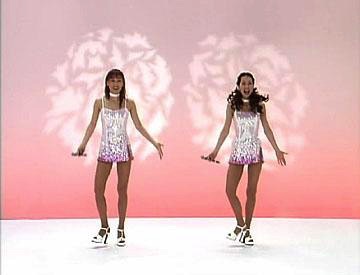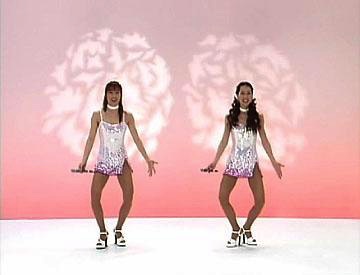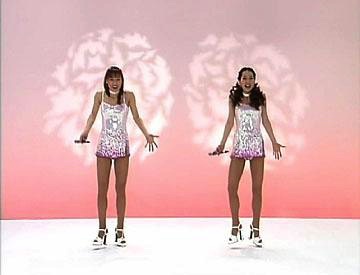ESSAY 5
DANCING QUEENS
The choreographic appeal of Pink Lady
by Jeffrey C. Branch
"You can dance, you can jive,
having the time of your life,
see that girl, watch that scene,
dig it, the dancing queen."
---from 'Dancing Queen' by ABBA
When Pink Lady burst on the Japanese pop music scene like a supernova in 1976, Mie and Kei were literally a bombshell, what with their wholesome good looks, sugary-sweet personalities and wonderfully harmonious singing skills. But the one thing that made Pink Lady such an incredible force as entertainers wasn’t just their singing, but the extraordinary dance routines that accompanied their hit songs, setting them far above the crowd. In my humble opinion, I’d even go so far as to say that if it weren’t for the dancing, Mie and Kei might not have become so unbelievably famous thirty years ago.
Before Mie and Kei made their stunning debut, female singers in Japan were rather sedate while performing. They didn’t do much in the way of moving, save for elaborate hand gestures and the like, similar to the legions of female singers and groups here in the States in the 1950’s and 60’s. Perhaps J-pop singers back then were patterned after their American counterparts; but then, along came Mie and Kei, doing those awesomely funky dance moves when they sprung “Pepper Keibu” on the crowd. According to the entry on Pink Lady in Mark Schilling’s book, The Encyclopedia of Japanese Pop Culture, nothing like Mie and Kei had ever been seen before, and fans were positively floored by what they saw. While the song itself was cute and peppy, it was the high energy dancing the girls did that really caught and held everyone’s attention.
Clearly, the bigwigs at Trust & Confidence--the company that managed Pink Lady from their inception--came up with a brainstorm by having Mie and Kei dance to their songs. The routines, a different one for each song were astounding in their complexity. Tthe late Kazuhiko Soma, the man who groomed the girls and taught them all their moves was a true visionary--a genius who shaped the image of Pink Lady as a dynamic song and dance act that captivated an entire country. Of course, it didn’t hurt that T & C also added the concept of dressing Mie and Kei in their fabulous stage costumes (like the cute baseball jumpers for “Southpaw” and the silver sequined bodysuits with matching antenna hats for “UFO”). Each outfit, as unique as the routines themselves, combined to create a total visual package that everyone dearly loved.
In no time at all, the dancing had become so integral to Pink Lady’s overall appeal that children, teens, even adults would boogie along with the girls at their concerts or when they made appearances on TV. Hell, it went even farther than that; on trading cards (most of which I’ve collected via online auctions) and one of the picture books I bought during my time spent in Japan, there were step-by-step illustrations of the routines for fans to learn and emulate. Watching the girls do their routines, going back to the late 1970’s to the end of their reunion tour just last year, I was amazed at the military-like precision Mie and Kei applied to the routines. Being an ex-military man myself, I’m certainly familiar with that particular concept. In fact, it was said that Soma was like a drill sergeant with the girls, pushing them long and hard to learn all their moves.
From “Pepper Keibu”: According to information John Vawter turned up several months ago, this portion of Pink Lady’s most famous dance routine was called---and, I swear to God I’m not making this up---‘the open crotch step’. Oy vey! However, in the interest of sensitivity (and the fact I crack up every time that’s mentioned), I prefer to call it simply, ‘the bunny hop’.
But, all that hard work paid off in spades as it looked like Mie and Kei could do those routines in their sleep. And there were certainly a lot of them, covering every Pink Lady song from “Pepper Keibu” to “World Hero History”, plus some of the more familiar B-sides like “Toast For Ladies”, and “Super Monkey”. On top of that, there were even routines for a few songs from the U.S. Album, like “Strangers When We Kiss” and “Love Countdown”. To watch the girls in action during their concerts, the energy they expended for both dancing AND singing must have been positively staggering. On more than a few occasions, I’ve joked to fellow fans that if Mie and Kei compiled their dance routines and turned it into an exercise video, they’d make a boatload of money because people would burn a ton of calories doing all that dancing!
That also reminded me of a magazine interview the girls did during their 1979 publicity tour in America, to promote their one and only all-English album. Mie stated that if she and Kei did any more dancing than they were already doing at the time, they wouldn’t be able to sing! And, given what I had seen of the Ladies, I could believe that! However, they struck a healthy balance between the two skills, and one never interfered with the other. Still, even without any substantial proof, it’s not too hard for me to speculate that Pink Lady’s lasting fame probably had more to do with the girls kicking up their heels than raising their voices in song. That the visual appeal of Mie and Kei-- dancing up a storm in their cute, flashy costumes--left a permanent impression on the minds of their legions of devoted fans (myself included) is beyond dispute.
Which brings us to the present day. Having attended one of the shows during Pink Lady’s reunion tour in the summer of 2003, and having watched the DVD’s of their final two concerts last May (see: Pink Review 2), I was blown away by how Mie and Kei, in their late 40’s, were still dancing with all the precision and passion they exuded back when they were in their early 20’s. Not only was that a testament to the remarkable physical condition the Ladies were in, but their tremendous desire to entertain their fans who had been so loyal to them for years, if not decades. The combination of Pink Lady’s golden voices AND their magic feet was what made them into the legendary megastars of Japan’s entertainment culture. In short, Mie and Kei danced their way into a country’s collective hearts, and never left.
Author’s note: A tip of the hat to fellow PL fan Lady-X who helped with the editing.
Click here for Pink Choreography 2 and the 2004 version of the dance routines




